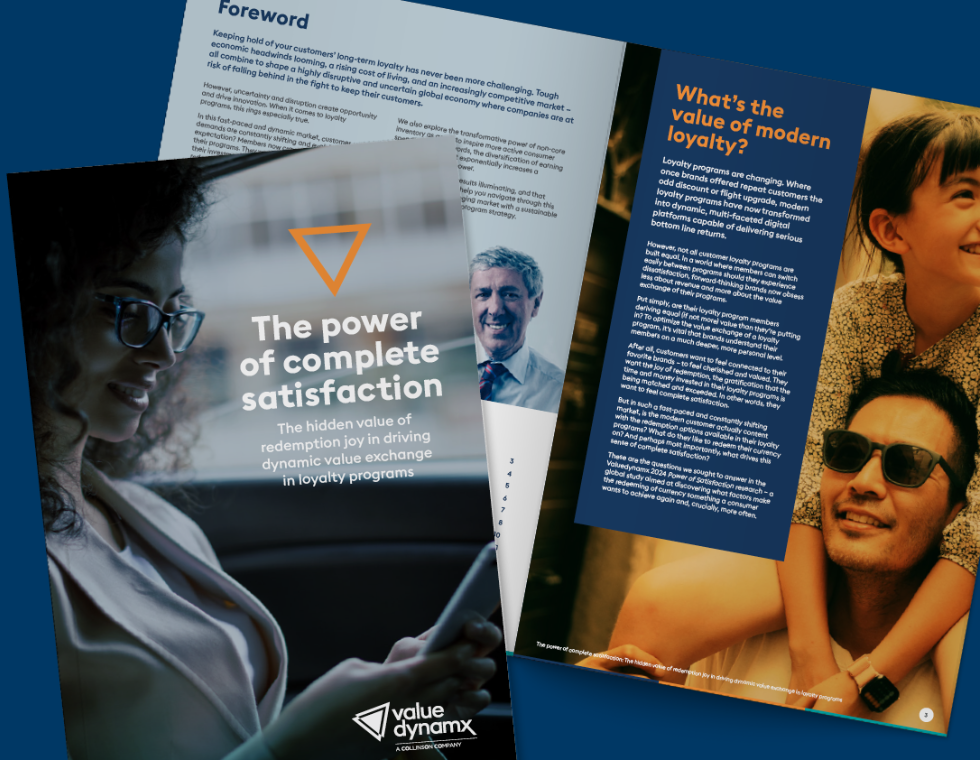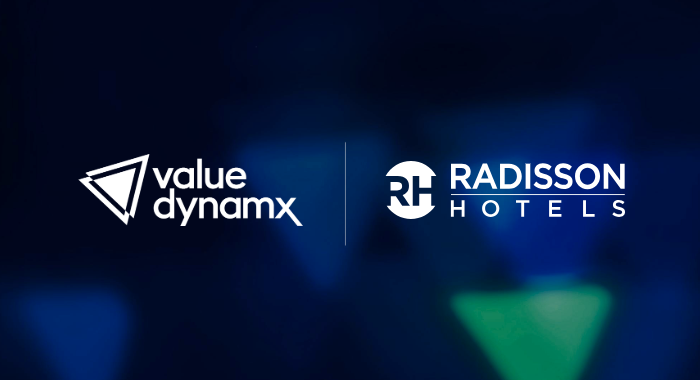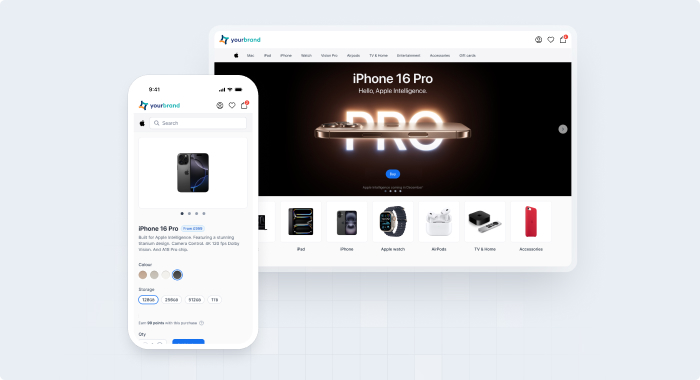Our new global research reveals the value of joyful reward redemption in driving loyalty program value and highlights opportunities to enhance satisfaction in reward earning and redemption offerings.
Our research highlights ripe opportunities for companies to enhance customer satisfaction and long-term engagement via loyalty programs. The study found that personalized, simplistic, gratifying, and frequent loyalty program reward earning and redemption opportunities strongly align with consumer expectations. These offerings also significantly increase greater satisfaction and more frequent customer interactions since they provide better perceived value for shoppers’ time and money.
“According to our research, forward-thinking brands must obsess over ensuring their loyalty program members derive equal, if not more, value than they invest,” said James Berry, Managing Director at Valuedynamx. “To optimize this value exchange, brands must understand their members on a deeper, more personal level to make them feel appreciated and cherished. This means providing ease of use, helpful recommendations, and most importantly, reward options that resonate and drive feelings of gratification. With satisfaction comes engagement—and an increase in the rate at which consumers earn and spend their rewards. This ongoing “earn and burn” cycle directly correlates with more frequent touchpoints that can drive increased revenue potential and loyalty program success for businesses.”
Our research: Power of Satisfaction , which surveyed more than 5,500 consumers enrolled in loyalty programs, uncovered the following key takeaways about what drives consumer satisfaction, engagement, and value in modern loyalty programs.
Simplicity and Satisfaction Drive Customer Loyalty and Engagement
There is a direct correlation between customer satisfaction and the rate at which loyalty program members engage in the program by redeeming/spending ("burning") and earning rewards ("earning"). Programs that exhibit a high spend rate often find that it equates to a higher earn rate and more satisfied members, likely thanks to more tailored reward and redemption options. In fact, consumers are willing to accept (and remain satisfied with) slightly lower monetary rewards if they are better personalized to their preferences for airlines, hotels, banks, and retailers.
With consumers juggling more apps, platforms, and digital services than ever, it should come as no surprise that the number one characteristic of a desirable and satisfying loyalty program is a simple redemption process. This simplicity extends to ease of use and cost-saving, with redemption options with the brand, savings, and easy-to-track balance and reward eligibility being the next most desirable program traits.
In general, the study found bountiful opportunities for brands to make customers feel their spending is worthwhile - leading to enhanced customer satisfaction in key areas such as redemption value, cost savings, and product offerings. Consumers surveyed often highlighted disappointment and dissatisfaction in reward value/discount savings, disproportionate savings relative to their spend, and dissatisfaction with limited selections of a brand’s product range.
Consumers Want Choices but Lack Options
There is a substantial opportunity for brands to enhance loyalty programs and satisfy their customers by expanding reward redemption options. This is evidenced by the fact that about two-thirds of loyalty program members are less than completely satisfied with the redemption options available to them. That same number of respondents actively seek to earn loyalty currency when rewards align with their individual preferences (such as the option to redeem for experiences and rewards from a variety of their favorite brands).
While the most popular types of loyalty currency are cashback and gift cards, the vast majority (90%) of program members want the flexibility to redeem loyalty points with multiple brands. Despite this overwhelming demand, many loyalty programs still limit redemption options to their own brand while fewer programs offer rewards and discounts across multiple brands. Further, nearly half of loyalty program members desire experiential reward options, but only 25% currently have access to them.
Brands looking to increase their “earn and burn” rate can turn to program characteristics most associated with complete satisfaction, such as the ability to redeem for memorable experiences, options to redeem with other brands, brand options that resonate with their interests, personalized reward options, and reward recommendations based on past purchases.
There is Strong Consumer Demand for Value and Personalized Rewards
Redemption events are not self-sufficient in driving future earning. Instead, the study found that loyalty program satisfaction is derived from a positive redemption event that creates joy when consumers feel the time and effort they have invested in a loyalty program has been sufficiently rewarded (called “redemption joy”). This joy can be nurtured when programs go above and beyond to create it—particularly through personalized rewards.
Approximately 30% of respondents expressed a preference for rewards based on their past purchases and when asked to rank which loyalty program traits increased their redemption satisfaction, helpful recommendations for reward redemptions ranked highest, closely followed by the ability to redeem high-value rewards and being offered unique and interesting reward options.
Customers want rewards that reflect their individual tastes and past interactions with brands and introducing artificial intelligence (AI) to find the rewards that best resonate with customers’ interests will drive redemption joy. The research even found that about two-thirds of respondents that see clear value in engaging with loyalty programs would be willing to share personalized data to better inform personalization strategy. This data sharing is becoming a cornerstone of modern loyalty programs and provides brands with a deeper understanding of customer preferences and behaviors to create rewards and experiences that resonate on an individual level.
Consumers Use Loyalty Rewards at High Frequency for Different Purposes
As economic challenges persist, consumers are “earning and burning” rewards frequently; 83% of respondents reported redeeming loyalty currency at least once in the last three months and half reported redeeming in the last month. Supermarket, credit card, airline, and hotel loyalty programs rank among the top-preferred options, likely due to their versatility and ability to offset everyday spending. Supermarket programs boast some of the most active loyalty program members as 82% of respondents reported redeeming rewards on groceries, while airline and hotel programs appeal to loyalty members looking to earn and burn more often to save on high-value rewards such as free flights or luxury hotel stays.
From a regional perspective, supermarket loyalty programs are particularly popular in Europe and Australia, reflecting the routine nature of grocery shopping in these regions. In contrast, credit cards are used more frequently in the United States (43%) and Brazil (39%), where consumers might be leveraging their cards for a variety of purchases to accumulate cashback. Meanwhile, airline loyalty programs are most popular in China (40%) and Hong Kong (37%), where the focus is often on saving points for significant travel-related rewards.
“These research findings present a significant opportunity for loyalty programs to re-evaluate and enhance their offerings, particularly by integrating personalized and experiential rewards that resonate with consumer preferences,” added Berry. “It’s not enough just to drive reward redemption, as unsatisfying or uninspired rewards do not actively drive richer, more frequent engagements. Instead, complementary and personalized “earn and burn” behavior is more likely to create ongoing loyalty program satisfaction. By seizing the opportunities identified by this research, loyalty programs can better meet the needs of their members and drive greater long-term customer engagement.”
About the Valuedynamx Power of Satisfaction Research 2024
A global study of 5,500+ respondents belonging to a loyalty program with 1+ airline, bank, credit card, or hotel. Survey respondents were surveyed in January 2024 via PureSpectrum.



